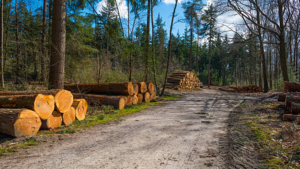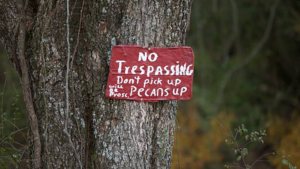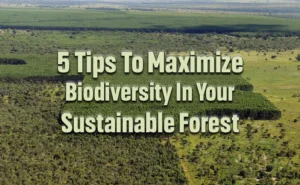How Forest Foods Can Save Our Ecosystems
- September 4, 2024
- 0 comment
Forests are more than just a collection of trees; they are dynamic ecosystems teeming with life. Among the many resources forests provide, forest-based foods stand out as vital components for both the environment and human societies. These foods, which include nuts, fruits, mushrooms, and medicinal plants, play a critical role in the health of ecosystems and the livelihoods of local communities. Sustainable forestry practices that embrace the cultivation and harvesting of these foods can help promote biodiversity, support ecological balance, and enhance food security.

As we explore the connections between forests, food, and sustainability, it becomes evident that forest-based foods are not just a byproduct of nature but a cornerstone of healthy, thriving ecosystems. By integrating these foods into sustainable forestry management, we can ensure that forests remain resilient, diverse, and productive for generations to come.
Table of Content
- The Diversity of Forest-Based Foods
- Enhancing Ecosystem Health Through Forest Foods
- Integrating Forest Foods into Sustainable Forestry Practices
- Economic and Social Benefits of Forest-Based Foods
- Challenges and Solutions in Managing Forest-Based Foods
- The Future of Forest-Based Foods in Sustainable Forestry
- FAQs
The Diversity of Forest-Based Foods

The richness of forest ecosystems is reflected in the diversity of foods they produce. From acorns to wild berries, forest-based foods encompass a wide range of edible products. These foods are often categorized into nuts, fruits, mushrooms, and medicinal plants. Nuts like chestnuts and walnuts provide essential nutrients, while fruits such as wild apples and berries offer a seasonal bounty. Mushrooms, ranging from the prized truffles to more common varieties, are a delicacy in many cultures. Medicinal plants like ginseng and echinacea have been used for centuries to treat ailments and promote health.
For many local communities, forest-based foods hold significant cultural and economic value. These foods are not only integral to traditional diets but also represent a source of income through trade and commerce. In modern times, there is a growing recognition of the importance of these foods in sustainable diets, as they offer diverse nutritional benefits while promoting ecological stewardship.
Enhancing Ecosystem Health Through Forest Foods

Forest-based foods do more than nourish humans; they also play a vital role in maintaining ecosystem health. These foods contribute to biodiversity by supporting a variety of plant and animal species. For instance, fruiting trees and shrubs provide food for wildlife, while mushrooms contribute to nutrient cycling and soil health. The symbiotic relationships between forest species and food production are essential for the stability of ecosystems.
Sustainable harvesting of forest foods is key to ensuring that these ecosystems remain resilient. When done responsibly, harvesting can enhance forest health by promoting the regeneration of plants and reducing the risk of overgrowth. By recognizing the ecological benefits of forest-based foods, we can implement practices that support both human needs and environmental sustainability.
Integrating Forest Foods into Sustainable Forestry Practices

Sustainable forestry is not solely about timber production; it also involves the management of all forest resources, including food. Integrating forest-based foods into forestry practices requires a holistic approach that balances ecological integrity with human use. Best practices include selective harvesting, which allows for the regeneration of food plants, and the preservation of habitats that support diverse species.
Agroforestry, a land-use system that combines forestry with agriculture, offers a promising model for integrating forest foods into sustainable practices. In agroforestry systems, food crops are cultivated alongside trees, providing both timber and food products. This approach not only diversifies income sources but also enhances soil health, reduces erosion, and promotes biodiversity. Examples of successful agroforestry projects can be found worldwide, where communities benefit from the multiple outputs of their forests without compromising the environment.
Economic and Social Benefits of Forest-Based Foods

The economic and social benefits of forest-based foods extend far beyond the forest boundaries. These foods provide vital income for rural communities, creating opportunities for local entrepreneurship and market development. The sale of forest products, such as wild mushrooms or medicinal herbs, can be a significant source of revenue, especially in regions where agriculture is challenging.
Moreover, forest-based foods contribute to food security by providing a reliable and diverse food supply. In areas prone to food shortages, these foods offer an essential safety net, ensuring that communities have access to nutritious and sustainable food sources. By promoting the cultivation and trade of forest foods, we can strengthen local economies and improve the well-being of communities that depend on forests for their livelihoods.
Challenges and Solutions in Managing Forest-Based Foods
While forest-based foods offer numerous benefits, their sustainable management presents several challenges. Overharvesting, driven by market demand and lack of regulation, threatens the availability of these foods. Habitat loss due to deforestation and land conversion further exacerbates the decline of forest food resources. Climate change, with its unpredictable effects on weather patterns and ecosystems, adds another layer of complexity to the management of these foods.
Addressing these challenges requires a multi-faceted approach. Effective conservation strategies, such as protected areas and sustainable harvesting guidelines, are essential to prevent overexploitation. Engaging local communities in the management and protection of forest resources ensures that traditional knowledge and practices are respected and maintained. Additionally, promoting responsible consumption and raising awareness about the importance of forest-based foods can help shift market dynamics toward sustainability.
The Future of Forest-Based Foods in Sustainable Forestry
As we look to the future, the role of forest-based foods in sustainable forestry will likely expand. Emerging trends in the cultivation and commercialization of these foods reflect a growing interest in natural, sustainable food sources. The potential of forest foods to contribute to climate change adaptation and mitigation is increasingly recognized, as these foods offer resilient and low-impact alternatives to conventional agriculture.
Innovative approaches, such as the development of forest food cooperatives and the integration of digital tools for monitoring and management, are helping to bridge the gap between traditional practices and modern needs. By fostering collaboration between stakeholders—from local communities to policymakers and businesses—we can ensure that forest-based foods remain a vital component of sustainable forestry and a pillar of ecological and social resilience.
Frequently Asked Questions (FAQs)
1. What are forest-based foods?
Forest-based foods are edible products sourced directly from forest ecosystems. These include nuts, fruits, mushrooms, medicinal plants, and other non-timber resources that are harvested sustainably from forests.
2. How do forest-based foods contribute to sustainable forestry management?
Forest-based foods support sustainable forestry by promoting biodiversity, enhancing ecosystem health, and providing economic benefits to local communities. Integrating these foods into forestry practices helps balance environmental conservation with human needs.
3. What types of forest-based foods are commonly found?
Common forest-based foods include nuts (e.g., chestnuts, walnuts), fruits (e.g., wild apples, berries), mushrooms (e.g., truffles, chanterelles), and medicinal plants (e.g., ginseng, echinacea).
4. Why are forest-based foods important for local communities?
Forest-based foods are culturally significant and economically valuable for local communities. They provide essential nutrition, support traditional diets, and offer opportunities for income generation through trade and commerce.
5. How do forest-based foods enhance ecosystem health?
Forest-based foods contribute to biodiversity by supporting various plant and animal species. Their sustainable harvesting ensures the regeneration of forest resources, maintains habitat stability, and fosters ecological resilience.
6. What are the best practices for integrating forest-based foods into sustainable forestry?
Best practices include selective harvesting, preserving habitats, and using agroforestry techniques. These methods allow for the production of both timber and food while maintaining ecological integrity.
7. What are the economic and social benefits of forest-based foods?
Forest-based foods provide economic opportunities through local markets and value chains. They contribute to food security, support livelihoods, and promote social well-being in rural communities.
8. What challenges are associated with managing forest-based foods?
Challenges include overharvesting, habitat loss, and the impacts of climate change. Addressing these issues requires sustainable management practices, conservation strategies, and community engagement.
9. How can the sustainable harvesting of forest-based foods be ensured?
Sustainable harvesting can be ensured through regulations, community-led management, and the promotion of responsible consumption. Educating consumers and producers about the importance of sustainable practices is also crucial.
10. What is the future of forest-based foods in sustainable forestry?
The future of forest-based foods lies in their increasing role in climate change adaptation, innovative cultivation methods, and the expansion of forest food markets. These foods are poised to become integral to sustainable forestry and global food systems.

Gilbert Griffin
Forestry AuthorGilbert Griffin is a forest management expert specializing in sustainable practices, forest health, conservation, and land management. With extensive knowledge in pest control, disease management, and habitat restoration, Gilbert develops strategies to preserve forest ecosystems and biodiversity. Passionate about the natural world, Gilbert adapts to changes in forest management and stays updated through continuous learning. Gilbert also provides seasonal advice to optimize forest care throughout the year.













Leave your comment